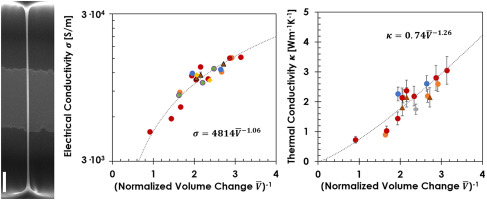Our official English website, www.x-mol.net, welcomes your
feedback! (Note: you will need to create a separate account there.)
Size-dependent electrical and thermal conductivities of electro-mechanically-spun glassy carbon wires
Carbon ( IF 10.5 ) Pub Date : 2018-04-01 , DOI: 10.1016/j.carbon.2017.12.113 Laia Ferrer-Argemi , Ehsan Shamloo Aliabadi , Albert Cisquella-Serra , Arnoldo Salazar , Marc Madou , Jaeho Lee
Carbon ( IF 10.5 ) Pub Date : 2018-04-01 , DOI: 10.1016/j.carbon.2017.12.113 Laia Ferrer-Argemi , Ehsan Shamloo Aliabadi , Albert Cisquella-Serra , Arnoldo Salazar , Marc Madou , Jaeho Lee

|
Abstract While electrical and thermal properties of glassy carbon are critical to performance metrics and fabrication processes of various carbon-based electronic and sensing devices, their size and process dependencies remain unclear due to limited experimental reports. In particular, the thermal conductivity of glassy carbon has received very little attention. Here, we have simultaneously characterized the electrical and thermal conductivities of individual glassy carbon wires (GCWs) using controlled electro-mechanical-spinning and electrical-resistance thermometry techniques. Despite the lack of electron or phonon boundary scattering, the GCW electrical conductivity varies from 477 to 18,100 S/m and its thermal conductivity varies from 0.7 to 4 Wm−1K−1 at room temperature, and these variations present no direct correlations with the GCW's diameter (630 nm - 3.5 μm), length (28–220 μm) or composition. We have identified empirical correlation fits with a volume change ratio that is induced by the carbonization process and we attribute the electrical and thermal conductivity variations to strain-driven volumetric changes in porosity and structural order. The experimental findings of this work enable precise understanding of electrical and thermal transport phenomena in glassy carbon and support developments of carbon-based micro-electro-mechanical systems for advanced electronic and sensing applications.
中文翻译:

机电纺玻璃碳丝的尺寸相关的电导率和热导率
摘要 虽然玻璃碳的电学和热学性质对各种碳基电子和传感设备的性能指标和制造工艺至关重要,但由于实验报告有限,它们的尺寸和工艺依赖性仍不清楚。尤其是玻碳的导热性很少受到关注。在这里,我们使用受控机电纺丝和电阻测温技术同时表征了单个玻璃碳线 (GCW) 的电导率和热导率。尽管缺乏电子或声子边界散射,GCW 电导率在室温下从 477 到 18,100 S/m 不等,其热导率从 0.7 到 4 Wm-1K-1 不等,这些变化与 GCW 没有直接相关性' s 直径 (630 nm - 3.5 μm)、长度 (28–220 μm) 或成分。我们已经确定了与由碳化过程引起的体积变化率的经验相关性拟合,并且我们将电导率和热导率的变化归因于孔隙率和结构顺序的应变驱动的体积变化。这项工作的实验结果能够精确理解玻璃碳中的电和热传输现象,并支持用于先进电子和传感应用的碳基微机电系统的开发。我们已经确定了与由碳化过程引起的体积变化率的经验相关性拟合,并且我们将电导率和热导率的变化归因于孔隙率和结构顺序的应变驱动的体积变化。这项工作的实验结果能够精确理解玻璃碳中的电和热传输现象,并支持用于先进电子和传感应用的碳基微机电系统的开发。我们已经确定了与由碳化过程引起的体积变化率的经验相关性拟合,并且我们将电导率和热导率的变化归因于孔隙率和结构顺序的应变驱动的体积变化。这项工作的实验结果能够精确理解玻璃碳中的电和热传输现象,并支持用于先进电子和传感应用的碳基微机电系统的开发。
更新日期:2018-04-01
中文翻译:

机电纺玻璃碳丝的尺寸相关的电导率和热导率
摘要 虽然玻璃碳的电学和热学性质对各种碳基电子和传感设备的性能指标和制造工艺至关重要,但由于实验报告有限,它们的尺寸和工艺依赖性仍不清楚。尤其是玻碳的导热性很少受到关注。在这里,我们使用受控机电纺丝和电阻测温技术同时表征了单个玻璃碳线 (GCW) 的电导率和热导率。尽管缺乏电子或声子边界散射,GCW 电导率在室温下从 477 到 18,100 S/m 不等,其热导率从 0.7 到 4 Wm-1K-1 不等,这些变化与 GCW 没有直接相关性' s 直径 (630 nm - 3.5 μm)、长度 (28–220 μm) 或成分。我们已经确定了与由碳化过程引起的体积变化率的经验相关性拟合,并且我们将电导率和热导率的变化归因于孔隙率和结构顺序的应变驱动的体积变化。这项工作的实验结果能够精确理解玻璃碳中的电和热传输现象,并支持用于先进电子和传感应用的碳基微机电系统的开发。我们已经确定了与由碳化过程引起的体积变化率的经验相关性拟合,并且我们将电导率和热导率的变化归因于孔隙率和结构顺序的应变驱动的体积变化。这项工作的实验结果能够精确理解玻璃碳中的电和热传输现象,并支持用于先进电子和传感应用的碳基微机电系统的开发。我们已经确定了与由碳化过程引起的体积变化率的经验相关性拟合,并且我们将电导率和热导率的变化归因于孔隙率和结构顺序的应变驱动的体积变化。这项工作的实验结果能够精确理解玻璃碳中的电和热传输现象,并支持用于先进电子和传感应用的碳基微机电系统的开发。











































 京公网安备 11010802027423号
京公网安备 11010802027423号